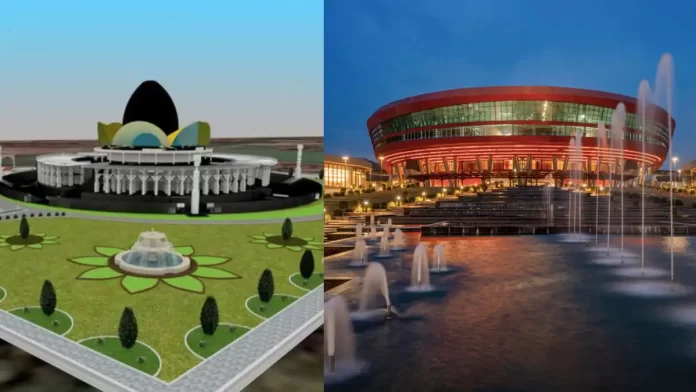Prime Minister, Narendra Modi on Wednesday inaugurated the International Exhibition-cum-Convention Centre (IECC) complex called ‘Bharat Mandapam’ at Pragati Maidan in New Delhi.
Speaking on the occasion, the PM elaborated that behind the name ‘Bharat Mandapam’ there is the inspiration of ‘Anubhav Mantapa’ of Bhagwan Basaveshwara. He said that Anubhav Mantapa represented the tradition of debate and expression.
Interestingly, the naming and inaugural ceremony of the Convention Centre as ‘Bharat Mandapam’ was carried out via drone, grand cultural programs and pompous Brahmanical rituals that Basava Basaveshwara openly preached against.
It may be noted that Lingayats do not follow Hindu-Brahmin religious practices such as yagnas.
Visioned by the Prime Minister and developed as a national project at a cost of about Rs 2700 crores, the new IECC complex at Pragati Maidan will help in promoting India as a global business destination.
What is Anubhav Mantapa?
Anubhava Mantapa was a public assembly and gathering forum founded by Basava or Basaveshwara, a Brahmin social reformer of the 12th century.
It was meant to attract men and women across various walks of life from distant lands to openly discuss spiritual, economic and social issues of life.
Though Anubhav Mantapa of Basaveshwara inspired the naming of the grand convention centre as Bharat Mandapam, according to PIB the architectural design of the building is inspired by Shankha (conch shell) a notable Brahmanical symbol.
Also, various paintings and Tribal art forms from different regions of the country adorn the Convention Centre.
Who was Basava?
Basava was born in 1131 CE in Karnataka in an Orthodox Brahmin family devoted to Hindu deity Shiva.
He married his maternal cousin whose father was the the Prime Minister of Bijjala, the Kalachuri king.
When his maternal uncle died, Basava became the new chief minister and also gave his sister in marriage to the king thus cementing his relations with the powerful royalty and nobility of the state.
Later, Basava used the state treasury to initiate a religious movement focussed on reviving Shaivism, recognising and empowering ascetics who were called Jangamas.
Philosophy of Basava
Basava spread social awareness through his poetry, popularly known as Vachanaas.
He reportedly rejected all superstitions and rituals and introduced new rituals like wearing Ishtalinga necklace (with an image of the Shiva Linga) of Rudraksha seeds or beads on parts of one body, and apply Vibhuti (sacred ash on forehead) as a constant reminder of one’s devotion and principles of faith.
His trinity consisted of Guru (teacher), Linga (personal symbol of Shiva) and Jangama (constantly moving and learning).
A recurring contrast in his poems and ideas is of Sthavara and Jangama, that is, of “what is static, standing” and “what is moving, seeking” respectively. Temples, ancient books represented the former, while work and discussion represented the latter.
According to Sripati, a Virasaiva scholar, Basava’s Lingayat theology is influenced by Vedanta and is a form of qualified non-dualism, wherein the individual Atma (soul) is the body of God, and that there is no difference between Shiva and Atma (self, soul), Shiva is one’s Atma, one’s Atma is Shiva.
Sripati’s analysis places Basava’s views in Vedanta school, in a form closer to the 11th century Vishishtadvaita philosopher Ramanuja, than to Advaita philosopher Adi Shankara.
With respect to the context, one must note that Basava’s movement coincided with the Bhakti Movement allegedly launched by Brahmin intelligentsia to counter the rapid conversion of masses to Islam that had already taken roots in India by 12th century and posed the greatest ever existential threat to Brahmanism in both North and South.
Grand Cultural Opening of Bharat Mandapam
During the inauguration of the International Convention Centre ‘Bharat Mandapam’, the Ministry of Culture, through its Sangeet Natak Akademi and the Zonal Cultural Centres presented a bouquet of cultural programmes with participation of around 1250 artists from across the nation.
Performances involving traditional musical instruments Nadaswaram, Thavil, Panchavadyam, Chenda, Dappu, Lezim, Nashik Dhol, Gujarat Dhol, Chattri, Dhak Dhol, Nagara, Shankh, and Ghanta, etc. formed part of the welcome performances and brought out the spirit of Ek Bharat Shreshtha Bharat.
More than 300 schoolchildren from Vidya Bharti sang “Ananda Loke” of Rabindranath Tagore as part of the Foyer performances.
The stage performances enthralled the audience and included Dhrupad by Sammit Mallik and group; a confluence of Indian classical dances – Bharatnatyam, Kathak, Kuchipudi and Odishi; Siddhi Dhamal; Dholu Kunita; Bihu; Baredi; Odishi dance by Padmashree Madhavi Mudgal and group; mask dance (Purulia Chhau); and Kathak by repertory artists and students of Kathak Kendra.
There was an enervating fifteen-minute performance ‘Ojasvi’ before the Prime Minister presenting choreographic dance presentation on the music of Shankar Mahadevan & Ricky Kej – Surya , Ganesha and Nataraja incorporating Chhau, Kathak, Odisshi, Bharatanatyam and contemporary dance forms by Santosh Nair and his Sadya group from Delhi.
‘Dhanya Bharatam’ song in Hindi language rendered in the Powada or Marathi folk singing style by Shri Nandesh Vatsala Vitthal Umap( Sangeet Natak Akademi Yuva awardee) accompanied by about 20 dancers representing various folk and major performing art forms imbued everybody with a sense of patriotism.
There were also about 28 spot performances featuring various folk and tribal art forms of the country creating a carnival- like atmosphere all around the Bharat Mandapam.
Earlier, in the morning there was a flute ensemble after the havan rendered by Shri Chetan Joshi, Sangeet Natak Akademi awardee, and his group which set the tone for the day’s events. Around 150 of the invited artists attended the havan.
